Edie Melson's Blog, page 361
November 4, 2015
Capturing Those Elusive Writing Ideas
 by Edie Melson @EdieMelson
by Edie Melson @EdieMelsonToday I’m over at Almost An Author talking about how I capture writing ideas.
As a writer, I’ve come to realize the value—and the elusiveness—of writing ideas. They come and go like beautiful blossoms in spring. And just like flowers, if we don’t pick them and save them, we lose them. So today I’d like to share some tips for catching and storing writing ideas.
Read more at Almost An Author!
Published on November 04, 2015 04:55
November 3, 2015
Turn Off Your Internal Editor with These tips
by Edie Melson @EdieMelson
 In honor of NaNoWriMo, I'm going to share some insights I've gleaned about writing a first draft.
In honor of NaNoWriMo, I'm going to share some insights I've gleaned about writing a first draft.I’ve spoken with a lot of writers who have trouble disconnecting their INTERNAL EDITOR when they're working on an early draft of a manuscript.
This overly helpful person lives inside most of us and comes in handy when we’re putting the finishing touches on our manuscript. But when we’re in the midst of a creative surge, that same person can short circuit our progress.
Today's post will give you the tips you need to turn off your internal editor.
First you should know there’s a scientific reason for that roadblock. The creative act of writing your first draft stems from the right side—or creative side—of the brain. Later in the process, when polishing begins, the left side takes over. Here are some of the characteristics of each side.
Right Brain
 Visual in process, focusing more on patterns and images.Generally intuitive, led by feelings.Is the epitome of multi-tasking, able to process ideas simultaneously.Progresses from the big picture to the details.Lacks organization, utilizes free association.Left Brain
Visual in process, focusing more on patterns and images.Generally intuitive, led by feelings.Is the epitome of multi-tasking, able to process ideas simultaneously.Progresses from the big picture to the details.Lacks organization, utilizes free association.Left BrainMore verbal, needs to find specific words to express ideas.Analytical, led by logic.Takes things step by step, one idea at a time.Organizes details first before moving to the big picture.Very organized, utilizing lists and detailed plans.Mixing up the process—trying to use both sides of the brain at the same time—can lead to a tangled mess and a major roadblock. All of this information is good to know, but what if our left-brained, Internal Editor won’t go away? How do we make her be quiet? Unfortunately, there isn’t one way that works for everyone, but here are some tips that should help.
 Tips1. Don’t give in to temptation. Our Internal Editor gets stronger the more frequently we give in to her demands. If she thinks you need a certain word before you can finish that sentence, stay strong. Type XXX and go on. Later, during the rewriting process, you’ll have plenty of time to find the right word. This goes for anything that demands you slow the creative process. At this point in your manuscript speed is your best friend.
Tips1. Don’t give in to temptation. Our Internal Editor gets stronger the more frequently we give in to her demands. If she thinks you need a certain word before you can finish that sentence, stay strong. Type XXX and go on. Later, during the rewriting process, you’ll have plenty of time to find the right word. This goes for anything that demands you slow the creative process. At this point in your manuscript speed is your best friend.2. Set a daily and weekly word count goal. This can often sidetrack the Internal Editor because of her need to meet a goal. Sometimes, in her drive to succeed she can even become an ally.
3. Make lists in a separate notebook. Use your computer for the story, but if the need for details overshadows the creative urge, make a quick note in a notebook. Don’t let yourself get bogged down, but let the free association part of your right brain give you ideas to explore later with your more logical left side.
4. Don’t give in to fear. Many times our Internal Editor is driven by fear. Fear that this draft isn’t good, won’t work or just doesn’t make sense. Remind yourself that this version isn’t written in stone. Sometimes just giving ourselves permission to write what Anne Lamott calls the sh*%&# first draft is all we need to derail our Internal Editor.
All of these can help, but I’d like to know what tricks you use to keep that INNER EDITOR quiet.
Don't forget to join the conversation!Blessings,Edie
TWEETABLES
Turn off Your Internal Editor When You #Write Your First Draft - @EdieMelson (Click to Tweet)
To Win at #NaNoWriMo Use These Tips to Turn Off Your Internal Editor - @EdieMelson (Click to Tweet)
Published on November 03, 2015 01:00
November 2, 2015
Author Marketing—Ways to Support Your Writing Friends WITHOUT Destroying Your Own Platform
By Edie Melson @EdieMelson
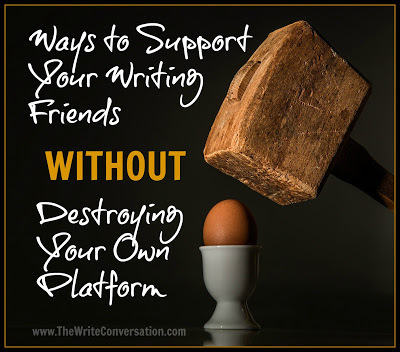 I think one of the most misunderstood aspects of being part of the community of writers is what our responsibilities are within that community. Our community could be an online group or a local group, large group or small one. Regardless, sooner or later, the invitation and/or expectation of cross marketing is going to come up.
I think one of the most misunderstood aspects of being part of the community of writers is what our responsibilities are within that community. Our community could be an online group or a local group, large group or small one. Regardless, sooner or later, the invitation and/or expectation of cross marketing is going to come up.
We have to be careful though, a request to promote another writer’s book or blog could be a bad idea. Today I want to take it slow and give you some tools to make the best decision for your specific circumstance.Promoting a New Release or a Special PriceHere’s how you may be approached:
 Things to consider when asked to promote something to
Things to consider when asked to promote something to
your audience. Scenario One: The request may come as a plea for help. The author asking for assistance usually makes an announcement to the group requesting help promoting an upcoming release or special price drop.
Scenario Two:Someone in the group may suggest that if all the authors within the group band together to promote one another’s work, they’ll reach more readers. Unchecked this can quickly become the expectation and focus of the group.
These two scenarios seem—on the surface—like good ideas. Truthfully, they’re usually not. But before I explain the pitfalls, let’s explore the purpose of promoting our books in the first place.
Background on Building a Strong PlatformAs writers, the basis of our platform is our readers. In a nutshell, we want to connect with the audience who reads what we write.
If we write science fiction, we’ll have one type of reader. If we write sweet romance, we’ll be attracting another type of reader. One audience isn’t better than another, but we must realize they’re different. They have different likes and expectations.
For example, those who read sweet romance, aren’t likely to cross over and read horror. This is a generalization and there will be exceptions, but we can’t market to the exceptions. We market to the target reader. This is the reason that authors brand themselves to a genre or two and don’t just write everything that comes to mind.
Once we realize how a healthy platform is built, we understand why our target marketing audience CANNOT be other writers. It’s just not reasonable to expect to build a strong, healthy platform on the backs of other writers.
Especially writers who have a totally different audience than the one we’re writing to.
The flip side of this is that we owe our reading audience our loyalty. Your readers have given you a trust. They read your books and follow you on social media. They have certain expectations based on they type of books you write. If we don’t deliver or if we drift too far afield from that subject, we’ll lose what we’ve built. And, if we promote books that our audience isn't interested in, we're not doing the authors we're promoting any favors. They won't gain any new readers and if these irritated readers remember the book, it will be in a negative light.
NOTE: if we’re publishing writing books or make a significant portion of our income by teaching other writers, then we can include them in our marketing plan. But even then, they are not the basis of an author’s platform.
Back to Requests to Promote a Fellow Author’s Book Scenario One:When other author ask me to help promote their books, I have to evaluate whether or not what they’ve written fits in with the readers I target. Personally, the novels I write are science fiction and steam punk. So if I’m asked to promote a book that this audience doesn’t normally read, I’ll choose to say no. There are exceptions to this. Sometimes I’m excited for a friend of mine and decide to expose my audience to something different. BUT it’s an exception. I cannot build a platform by promoting everyone else’s books.Scenario Two: In my opinion (and many other writers and authors) the primary purpose of a writers group is to teach and share important aspects of the writing and publishing journey. It’s a place to learn about writing and publishing. It’s also a place to encourage one another. The writing journey is tough and we need traveling companions who understand the struggles and joys we encounter along the way. I do not think a writer’s group has any obligation to promote one another’s books at the expense of respecting the audience we’ve chosen to serve. Beyond that, a writer’s group with this expectation isn’t going to attract professional writers because they know this isn’t a healthy way to approach marketing and won’t be a part of it.Are there times to promote other books?Yes. If we write to the same audience, we can cross promote. But even then, we have to bee careful. We don't want our social media feeds to read like one long commercial. So we want to break up book promotion (even some one else's) with other types of social media updates.
Scenario One:When other author ask me to help promote their books, I have to evaluate whether or not what they’ve written fits in with the readers I target. Personally, the novels I write are science fiction and steam punk. So if I’m asked to promote a book that this audience doesn’t normally read, I’ll choose to say no. There are exceptions to this. Sometimes I’m excited for a friend of mine and decide to expose my audience to something different. BUT it’s an exception. I cannot build a platform by promoting everyone else’s books.Scenario Two: In my opinion (and many other writers and authors) the primary purpose of a writers group is to teach and share important aspects of the writing and publishing journey. It’s a place to learn about writing and publishing. It’s also a place to encourage one another. The writing journey is tough and we need traveling companions who understand the struggles and joys we encounter along the way. I do not think a writer’s group has any obligation to promote one another’s books at the expense of respecting the audience we’ve chosen to serve. Beyond that, a writer’s group with this expectation isn’t going to attract professional writers because they know this isn’t a healthy way to approach marketing and won’t be a part of it.Are there times to promote other books?Yes. If we write to the same audience, we can cross promote. But even then, we have to bee careful. We don't want our social media feeds to read like one long commercial. So we want to break up book promotion (even some one else's) with other types of social media updates.
What About Blogs and Social Media?Fellow authors may also request that members of their writing group follow their blog and follow them on social media.
BlogsI think subscribing to another author’s blog is a good way to support that author, regardless of what they right with one caveat. I don’t share the blog posts of other authors UNLESS they will interest my target audience. AND I don’t expect them to share mind. For example, my good friend and critique partner, Lynette Eason, rarely shares my blog posts. My blog is targeted toward writers. The basis of her social media is readers. They just aren’t interested in my writing blog. If she shared it often, she’d run the risk of alienating her audience and the sacrifice wouldn’t net me much benefit because her audience isn’t the target audience of my blog. Subscribing to another author’s blog is a good way to help their numbers increase.
NOTE: Here’s a post to help clarify the difference between blog FOLLOWERS and blog SUBSCRIBERS.
Social MediaI look at following other authors on social media the same way that I approach subscribing to their blogs. As long as they understand my parameters of when I’ll share something, I’m happy to add to their numbers.
 So How CAN I Help Fellow Authors?There are a lot of things we can do to support each other. Here are just a few:1. Post a book review. This is the NUMBER ONE way we can help one another. Book reviews are worth solid gold. When someone posts a review for me, it’s like getting a huge gift.
So How CAN I Help Fellow Authors?There are a lot of things we can do to support each other. Here are just a few:1. Post a book review. This is the NUMBER ONE way we can help one another. Book reviews are worth solid gold. When someone posts a review for me, it’s like getting a huge gift.
2. Subscribe to their blog and visit it regularly. This will help increase their numbers, which will help with publishers and agents.
3. Follow them on social media. Again, this will help with their numbers when they approach a publisher and/or agent.
4. Recommend their books to your local bookstore and library. This isn’t the same as promoting a book to your reading audience. But chances are you have a relationship with your local merchants (if you don’t, you should, but that’s another post!) and a personal recommendation can go a long way to getting author's books in a store.
Bottom LineWhen I’m asked to promote something to my audience, my first loyalty is to my audience. It has to be.
My audience has given me their trust. And I cannot, in good conscience, betray that trust by promoting every random thing I’m exposed to. EVEN if those random things are good ones.
There are times when I share things that don’t fit these parameters. I share some personal things on social media, like when I signed with an agent or got a new book contract. I even pass on things that just tickle my funny bone.
The important thing is that I make sure these are the EXCEPTION in my regular updates, never the rule.
Truthfully I can’t promote everything I’d like to for my friends because I’d end up driving away my audience. I always try to explain, and most of the time I’m met with understanding.
I don’t mind being asked to share information through my social media channels. Heck it’s a great way for me to be valuable with my audience. But I still have to know when to say no. It’s a ticklish line to walk, but it’s a boundary all of us need to establish if we want to keep the respect of those who follow us.
So how about you? How do you respond when friends ask you to share information through your social media platform? Be sure to leave your thoughts in the comments section below.
Don't forget to join the conversation!
Blessings,
Edie
TWEETABLES
Author #Marketing—Support Your #Writing Friends Without Destroying Your Platform @EdieMelson (Click to Tweet)
Be Smart When Other Authors Ask You to Cross Promote - @EdieMelson (Click to Tweet)
 I think one of the most misunderstood aspects of being part of the community of writers is what our responsibilities are within that community. Our community could be an online group or a local group, large group or small one. Regardless, sooner or later, the invitation and/or expectation of cross marketing is going to come up.
I think one of the most misunderstood aspects of being part of the community of writers is what our responsibilities are within that community. Our community could be an online group or a local group, large group or small one. Regardless, sooner or later, the invitation and/or expectation of cross marketing is going to come up. We have to be careful though, a request to promote another writer’s book or blog could be a bad idea. Today I want to take it slow and give you some tools to make the best decision for your specific circumstance.Promoting a New Release or a Special PriceHere’s how you may be approached:
 Things to consider when asked to promote something to
Things to consider when asked to promote something toyour audience. Scenario One: The request may come as a plea for help. The author asking for assistance usually makes an announcement to the group requesting help promoting an upcoming release or special price drop.
Scenario Two:Someone in the group may suggest that if all the authors within the group band together to promote one another’s work, they’ll reach more readers. Unchecked this can quickly become the expectation and focus of the group.
These two scenarios seem—on the surface—like good ideas. Truthfully, they’re usually not. But before I explain the pitfalls, let’s explore the purpose of promoting our books in the first place.
Background on Building a Strong PlatformAs writers, the basis of our platform is our readers. In a nutshell, we want to connect with the audience who reads what we write.
If we write science fiction, we’ll have one type of reader. If we write sweet romance, we’ll be attracting another type of reader. One audience isn’t better than another, but we must realize they’re different. They have different likes and expectations.
For example, those who read sweet romance, aren’t likely to cross over and read horror. This is a generalization and there will be exceptions, but we can’t market to the exceptions. We market to the target reader. This is the reason that authors brand themselves to a genre or two and don’t just write everything that comes to mind.
Once we realize how a healthy platform is built, we understand why our target marketing audience CANNOT be other writers. It’s just not reasonable to expect to build a strong, healthy platform on the backs of other writers.
Especially writers who have a totally different audience than the one we’re writing to.
The flip side of this is that we owe our reading audience our loyalty. Your readers have given you a trust. They read your books and follow you on social media. They have certain expectations based on they type of books you write. If we don’t deliver or if we drift too far afield from that subject, we’ll lose what we’ve built. And, if we promote books that our audience isn't interested in, we're not doing the authors we're promoting any favors. They won't gain any new readers and if these irritated readers remember the book, it will be in a negative light.
NOTE: if we’re publishing writing books or make a significant portion of our income by teaching other writers, then we can include them in our marketing plan. But even then, they are not the basis of an author’s platform.
Back to Requests to Promote a Fellow Author’s Book
 Scenario One:When other author ask me to help promote their books, I have to evaluate whether or not what they’ve written fits in with the readers I target. Personally, the novels I write are science fiction and steam punk. So if I’m asked to promote a book that this audience doesn’t normally read, I’ll choose to say no. There are exceptions to this. Sometimes I’m excited for a friend of mine and decide to expose my audience to something different. BUT it’s an exception. I cannot build a platform by promoting everyone else’s books.Scenario Two: In my opinion (and many other writers and authors) the primary purpose of a writers group is to teach and share important aspects of the writing and publishing journey. It’s a place to learn about writing and publishing. It’s also a place to encourage one another. The writing journey is tough and we need traveling companions who understand the struggles and joys we encounter along the way. I do not think a writer’s group has any obligation to promote one another’s books at the expense of respecting the audience we’ve chosen to serve. Beyond that, a writer’s group with this expectation isn’t going to attract professional writers because they know this isn’t a healthy way to approach marketing and won’t be a part of it.Are there times to promote other books?Yes. If we write to the same audience, we can cross promote. But even then, we have to bee careful. We don't want our social media feeds to read like one long commercial. So we want to break up book promotion (even some one else's) with other types of social media updates.
Scenario One:When other author ask me to help promote their books, I have to evaluate whether or not what they’ve written fits in with the readers I target. Personally, the novels I write are science fiction and steam punk. So if I’m asked to promote a book that this audience doesn’t normally read, I’ll choose to say no. There are exceptions to this. Sometimes I’m excited for a friend of mine and decide to expose my audience to something different. BUT it’s an exception. I cannot build a platform by promoting everyone else’s books.Scenario Two: In my opinion (and many other writers and authors) the primary purpose of a writers group is to teach and share important aspects of the writing and publishing journey. It’s a place to learn about writing and publishing. It’s also a place to encourage one another. The writing journey is tough and we need traveling companions who understand the struggles and joys we encounter along the way. I do not think a writer’s group has any obligation to promote one another’s books at the expense of respecting the audience we’ve chosen to serve. Beyond that, a writer’s group with this expectation isn’t going to attract professional writers because they know this isn’t a healthy way to approach marketing and won’t be a part of it.Are there times to promote other books?Yes. If we write to the same audience, we can cross promote. But even then, we have to bee careful. We don't want our social media feeds to read like one long commercial. So we want to break up book promotion (even some one else's) with other types of social media updates. What About Blogs and Social Media?Fellow authors may also request that members of their writing group follow their blog and follow them on social media.
BlogsI think subscribing to another author’s blog is a good way to support that author, regardless of what they right with one caveat. I don’t share the blog posts of other authors UNLESS they will interest my target audience. AND I don’t expect them to share mind. For example, my good friend and critique partner, Lynette Eason, rarely shares my blog posts. My blog is targeted toward writers. The basis of her social media is readers. They just aren’t interested in my writing blog. If she shared it often, she’d run the risk of alienating her audience and the sacrifice wouldn’t net me much benefit because her audience isn’t the target audience of my blog. Subscribing to another author’s blog is a good way to help their numbers increase.
NOTE: Here’s a post to help clarify the difference between blog FOLLOWERS and blog SUBSCRIBERS.
Social MediaI look at following other authors on social media the same way that I approach subscribing to their blogs. As long as they understand my parameters of when I’ll share something, I’m happy to add to their numbers.
 So How CAN I Help Fellow Authors?There are a lot of things we can do to support each other. Here are just a few:1. Post a book review. This is the NUMBER ONE way we can help one another. Book reviews are worth solid gold. When someone posts a review for me, it’s like getting a huge gift.
So How CAN I Help Fellow Authors?There are a lot of things we can do to support each other. Here are just a few:1. Post a book review. This is the NUMBER ONE way we can help one another. Book reviews are worth solid gold. When someone posts a review for me, it’s like getting a huge gift. 2. Subscribe to their blog and visit it regularly. This will help increase their numbers, which will help with publishers and agents.
3. Follow them on social media. Again, this will help with their numbers when they approach a publisher and/or agent.
4. Recommend their books to your local bookstore and library. This isn’t the same as promoting a book to your reading audience. But chances are you have a relationship with your local merchants (if you don’t, you should, but that’s another post!) and a personal recommendation can go a long way to getting author's books in a store.
Bottom LineWhen I’m asked to promote something to my audience, my first loyalty is to my audience. It has to be.
My audience has given me their trust. And I cannot, in good conscience, betray that trust by promoting every random thing I’m exposed to. EVEN if those random things are good ones.
There are times when I share things that don’t fit these parameters. I share some personal things on social media, like when I signed with an agent or got a new book contract. I even pass on things that just tickle my funny bone.
The important thing is that I make sure these are the EXCEPTION in my regular updates, never the rule.
Truthfully I can’t promote everything I’d like to for my friends because I’d end up driving away my audience. I always try to explain, and most of the time I’m met with understanding.
I don’t mind being asked to share information through my social media channels. Heck it’s a great way for me to be valuable with my audience. But I still have to know when to say no. It’s a ticklish line to walk, but it’s a boundary all of us need to establish if we want to keep the respect of those who follow us.
So how about you? How do you respond when friends ask you to share information through your social media platform? Be sure to leave your thoughts in the comments section below.
Don't forget to join the conversation!
Blessings,
Edie
TWEETABLES
Author #Marketing—Support Your #Writing Friends Without Destroying Your Platform @EdieMelson (Click to Tweet)
Be Smart When Other Authors Ask You to Cross Promote - @EdieMelson (Click to Tweet)
Published on November 02, 2015 01:00
November 1, 2015
More Than the Faith of a Headless Horseman
The heart is more deceitful than anything else,
and incurable—who can understand it? Jeremiah 17:9
 Fall is everywhere around us.Yesterday was Halloween. With Thanksgiving soon to follow, everywhere we look evidence of the season jumps out at us. The trees have donned their colorful best and pumpkins are sprouting grins on every front porch. Along with this, some classics have also come back to haunt us—from
It’s the Great Pumpkin Charlie Brown
to
The Legend of Sleepy Hollow
.
Fall is everywhere around us.Yesterday was Halloween. With Thanksgiving soon to follow, everywhere we look evidence of the season jumps out at us. The trees have donned their colorful best and pumpkins are sprouting grins on every front porch. Along with this, some classics have also come back to haunt us—from
It’s the Great Pumpkin Charlie Brown
to
The Legend of Sleepy Hollow
.
It’s that classic book by Washington Irving which has caught my mind’s eye this year—or more specifically a character within the book. As I was watching a rerun of Disney’s version, I was struck by how I resemble the Headless Horseman when it comes to faith.
 As I write out that thought I have to stop and—even though I know it’s true—I stare at it and consider it yet again. I’m so connected with my feelings—with my heart—it seems wrong not to weight the entire formula with emotion. It’s something I struggle with. I guess I truly am a product of my generation.Do what feels good.Follow your heart.Get in touch with your feelings.
As I write out that thought I have to stop and—even though I know it’s true—I stare at it and consider it yet again. I’m so connected with my feelings—with my heart—it seems wrong not to weight the entire formula with emotion. It’s something I struggle with. I guess I truly am a product of my generation.Do what feels good.Follow your heart.Get in touch with your feelings.
Each of those statements have a certain validity—for specific situations. But they are NOTthings on which to base your life. Because, ultimately, they are in direct conflict with Scripture.
God is a God of concrete facts. He is the head of my faith. And THAT’S the strong foundation I'm choosing to build my life on.
FACT ONEGod is ALWAYS true to His word.
MythI don’t always feel the assurance that it’s true. Some days I stumble, I make wrong choices. I’m overwhelmed with guilt. I don’t feel like I’m part of the family.
TruthGod’s promise of salvation doesn’t rest in me. It’s predicated by HIS goodness and mercy.
FACT TWOGod loves me . . . no matter what.
 I'm often prickly and unloveable.MythI’m often unlovable. Don’t believe me? Just ask my family. I’m not perfect and I seem intent in proving that on a daily—sometimes hourly—basis.
I'm often prickly and unloveable.MythI’m often unlovable. Don’t believe me? Just ask my family. I’m not perfect and I seem intent in proving that on a daily—sometimes hourly—basis.
TruthGod’s love isn’t dependent on my actions. He loves me for reasons I can’t quite comprehend. Because He created me, because He knows my potential, because He has named me, because He loves me.
FACT THREEGod works all things together for good for those who love Him and are called to His purpose.
 MythJust look around. The world is in a mess. Bad things happen to good people. Good things happen to bad people.
MythJust look around. The world is in a mess. Bad things happen to good people. Good things happen to bad people.
TruthNarrow your focus. Taken case by case we can see hints of this truth. But the ultimate truth is that the end isn’t here yet. We can’t know how God ties up all the threads and finishes off the tapestry.
So again I say, Faith is based on fact not feelings. This time the words come with confidence and with gratitude. I am a woman swayed by emotion—often lured down the wrong path by following my deceitful heart.
When I’m swayed by those emotions, I can end up like the headless horseman, cutting down people on all sides as I flounder through life blinded by following my heart without the knowledge of Christ.
God is solid beyond the momentary whims of feelings. His truth is certain, enduring for eternity.
 Fall is everywhere around us.Yesterday was Halloween. With Thanksgiving soon to follow, everywhere we look evidence of the season jumps out at us. The trees have donned their colorful best and pumpkins are sprouting grins on every front porch. Along with this, some classics have also come back to haunt us—from
It’s the Great Pumpkin Charlie Brown
to
The Legend of Sleepy Hollow
.
Fall is everywhere around us.Yesterday was Halloween. With Thanksgiving soon to follow, everywhere we look evidence of the season jumps out at us. The trees have donned their colorful best and pumpkins are sprouting grins on every front porch. Along with this, some classics have also come back to haunt us—from
It’s the Great Pumpkin Charlie Brown
to
The Legend of Sleepy Hollow
.It’s that classic book by Washington Irving which has caught my mind’s eye this year—or more specifically a character within the book. As I was watching a rerun of Disney’s version, I was struck by how I resemble the Headless Horseman when it comes to faith.
 As I write out that thought I have to stop and—even though I know it’s true—I stare at it and consider it yet again. I’m so connected with my feelings—with my heart—it seems wrong not to weight the entire formula with emotion. It’s something I struggle with. I guess I truly am a product of my generation.Do what feels good.Follow your heart.Get in touch with your feelings.
As I write out that thought I have to stop and—even though I know it’s true—I stare at it and consider it yet again. I’m so connected with my feelings—with my heart—it seems wrong not to weight the entire formula with emotion. It’s something I struggle with. I guess I truly am a product of my generation.Do what feels good.Follow your heart.Get in touch with your feelings.Each of those statements have a certain validity—for specific situations. But they are NOTthings on which to base your life. Because, ultimately, they are in direct conflict with Scripture.
God is a God of concrete facts. He is the head of my faith. And THAT’S the strong foundation I'm choosing to build my life on.
FACT ONEGod is ALWAYS true to His word.
MythI don’t always feel the assurance that it’s true. Some days I stumble, I make wrong choices. I’m overwhelmed with guilt. I don’t feel like I’m part of the family.
TruthGod’s promise of salvation doesn’t rest in me. It’s predicated by HIS goodness and mercy.
FACT TWOGod loves me . . . no matter what.
 I'm often prickly and unloveable.MythI’m often unlovable. Don’t believe me? Just ask my family. I’m not perfect and I seem intent in proving that on a daily—sometimes hourly—basis.
I'm often prickly and unloveable.MythI’m often unlovable. Don’t believe me? Just ask my family. I’m not perfect and I seem intent in proving that on a daily—sometimes hourly—basis.TruthGod’s love isn’t dependent on my actions. He loves me for reasons I can’t quite comprehend. Because He created me, because He knows my potential, because He has named me, because He loves me.
FACT THREEGod works all things together for good for those who love Him and are called to His purpose.
 MythJust look around. The world is in a mess. Bad things happen to good people. Good things happen to bad people.
MythJust look around. The world is in a mess. Bad things happen to good people. Good things happen to bad people.TruthNarrow your focus. Taken case by case we can see hints of this truth. But the ultimate truth is that the end isn’t here yet. We can’t know how God ties up all the threads and finishes off the tapestry.
So again I say, Faith is based on fact not feelings. This time the words come with confidence and with gratitude. I am a woman swayed by emotion—often lured down the wrong path by following my deceitful heart.
When I’m swayed by those emotions, I can end up like the headless horseman, cutting down people on all sides as I flounder through life blinded by following my heart without the knowledge of Christ.
God is solid beyond the momentary whims of feelings. His truth is certain, enduring for eternity.
Published on November 01, 2015 01:00
October 31, 2015
Don't Forget to Set Your Clocks Back an Hour
I thought I'd post a friendly reminder you can share on social media.

Be sure to share your thoughts in the comments section below.
I invite you to use this image any way you like online. Post it to your blog, share it on Facebook, Twitter, Pinterest, anywhere you'd like. All I ask is that you keep it intact, with my website watermark visible.
Don't forget to join the conversation!Blessings,Edie
TWEETABLE
Don't forget to set your clocks back an hour tonight! @EdieMelson (Click to Tweet)

Be sure to share your thoughts in the comments section below.
I invite you to use this image any way you like online. Post it to your blog, share it on Facebook, Twitter, Pinterest, anywhere you'd like. All I ask is that you keep it intact, with my website watermark visible.
Don't forget to join the conversation!Blessings,Edie
TWEETABLE
Don't forget to set your clocks back an hour tonight! @EdieMelson (Click to Tweet)
Published on October 31, 2015 05:17
October 30, 2015
Face Your Writing Fears—9 Tips to Keep from Becoming a Scaredy-Cat Writer
by Edie Melson @EdieMelson
 The season of spooks is upon us, but that doesn’t mean we can give in to the fears we face as writers. We must face our writing fears and keep moving.
The season of spooks is upon us, but that doesn’t mean we can give in to the fears we face as writers. We must face our writing fears and keep moving.
The other day I was talking to a friend of mine and this person confided that she was afraid she didn’t have what it takes to be a writer. “I’m just not good enough to get a book published, and I don’t know if I ever will be.”
“Welcome to the club,” I told her.
My answer wasn’t what she expected. She had forgotten something we had heard together at a conference many years ago. We’d been listening to an established author talk about his own fear and inadequacies. He told the audience that every time he sits down to write a new book, the fears resurface and he’s certain he no longer has what it takes to make it in publishing.
Hearing him confess his own fears gave me hope. Beyond that, it brought home an important fact. Being published—no matter if it’s a single book or a hundred—won’t necessarily make the fear disappear.
So what’s a writer to do?Tips to Keep From Becoming a Scaredy-Cat Writer Don't be a Scaredy-Cat Writer1. Write Regularly.For some of us that means daily. For others it means on the weekend, or three days a week. The truth is, mood is a fickle mistress and time is NEVER lying around waiting to be found!
Don't be a Scaredy-Cat Writer1. Write Regularly.For some of us that means daily. For others it means on the weekend, or three days a week. The truth is, mood is a fickle mistress and time is NEVER lying around waiting to be found!
2. Choose to Ignore the Negative Voices in Your Head. We all have them—those irritating whispers that tell us we’re not good enough, and we’re selfish to even try to follow our dreams. We can write anyway, or we can cave in to our insecurities. Published writers keep writing, no matter what those voices say. 3. Write Outside Your Comfort Zone. The publishing industry is in a constant state of change. What you write today, may not be popular five years from now. As a writer, you’ll have to constantly be changing and growing. Get used to it now and avoid the deer-in-the-headlights reaction when change comes your way.
4. Find a Writing Tribe. This is a tough enough business without trying to fly solo. We all need fellow writers who understand what we’re doing. These fellow travelers will keep us accountable and encourage us when we think we can’t go any further.
 Write when you don't have the time.5. Write When You Don’t Have the Time. So often I hear people who want to be published talk about how they’ll start when they find the time. The truth is that time is NEVER lying around waiting to be found. Following our dreams takes sacrifice. We must be willing to make the hard choices and carve out time to write.
Write when you don't have the time.5. Write When You Don’t Have the Time. So often I hear people who want to be published talk about how they’ll start when they find the time. The truth is that time is NEVER lying around waiting to be found. Following our dreams takes sacrifice. We must be willing to make the hard choices and carve out time to write.
6. Stay Active in the Industry. Join writing groups—locally and online. Give back to the writing community at large by volunteering to help others. Trust me when I tell you that no matter where you are in your writing journey, there are those less experienced. And by staying active, it’s harder to quit. The times I’ve wanted to throw in the towel it was having to answer to others that kept me going.
 Write when you're not inspired.7. Write When You’re NOT Inspired. We cannot wait for the mood strike to write. Inspiration is a fickle mistress. If we’re serious about pursuing publishing dreams, we must move beyond depending on our mood to be able to write.
Write when you're not inspired.7. Write When You’re NOT Inspired. We cannot wait for the mood strike to write. Inspiration is a fickle mistress. If we’re serious about pursuing publishing dreams, we must move beyond depending on our mood to be able to write.
8. Remind Yourself Why You Write. For me, written words are the way I process life. I don’t talk things out, I write things out. God designed me to be like this. Writing is His gift to me. I have those words taped above my desk so I’ll never forget.
9. Write Through the Fear.Being a published writer goes hand in hand with fear. We’re afraid we won’t be good enough to be published, then that no one will read the book, and finally that we won’t be able to write another book.
These are my tips to keep from being a scaredy-cat writer. What would you add to the list? Be sure to share your thoughts in the comments section below.
Don’t forget to join the conversation!Blessings,Edie
TWEETABLES9 Tips to Keep from Becoming a Scaredy-Cat Writer – via author @EdieMelson(Click to Tweet)
Face down your #writing fears with these 9 tipsfrom author @EdieMelson (Click to Tweet)
 The season of spooks is upon us, but that doesn’t mean we can give in to the fears we face as writers. We must face our writing fears and keep moving.
The season of spooks is upon us, but that doesn’t mean we can give in to the fears we face as writers. We must face our writing fears and keep moving.The other day I was talking to a friend of mine and this person confided that she was afraid she didn’t have what it takes to be a writer. “I’m just not good enough to get a book published, and I don’t know if I ever will be.”
“Welcome to the club,” I told her.
My answer wasn’t what she expected. She had forgotten something we had heard together at a conference many years ago. We’d been listening to an established author talk about his own fear and inadequacies. He told the audience that every time he sits down to write a new book, the fears resurface and he’s certain he no longer has what it takes to make it in publishing.
Hearing him confess his own fears gave me hope. Beyond that, it brought home an important fact. Being published—no matter if it’s a single book or a hundred—won’t necessarily make the fear disappear.
So what’s a writer to do?Tips to Keep From Becoming a Scaredy-Cat Writer
 Don't be a Scaredy-Cat Writer1. Write Regularly.For some of us that means daily. For others it means on the weekend, or three days a week. The truth is, mood is a fickle mistress and time is NEVER lying around waiting to be found!
Don't be a Scaredy-Cat Writer1. Write Regularly.For some of us that means daily. For others it means on the weekend, or three days a week. The truth is, mood is a fickle mistress and time is NEVER lying around waiting to be found!2. Choose to Ignore the Negative Voices in Your Head. We all have them—those irritating whispers that tell us we’re not good enough, and we’re selfish to even try to follow our dreams. We can write anyway, or we can cave in to our insecurities. Published writers keep writing, no matter what those voices say. 3. Write Outside Your Comfort Zone. The publishing industry is in a constant state of change. What you write today, may not be popular five years from now. As a writer, you’ll have to constantly be changing and growing. Get used to it now and avoid the deer-in-the-headlights reaction when change comes your way.
4. Find a Writing Tribe. This is a tough enough business without trying to fly solo. We all need fellow writers who understand what we’re doing. These fellow travelers will keep us accountable and encourage us when we think we can’t go any further.
 Write when you don't have the time.5. Write When You Don’t Have the Time. So often I hear people who want to be published talk about how they’ll start when they find the time. The truth is that time is NEVER lying around waiting to be found. Following our dreams takes sacrifice. We must be willing to make the hard choices and carve out time to write.
Write when you don't have the time.5. Write When You Don’t Have the Time. So often I hear people who want to be published talk about how they’ll start when they find the time. The truth is that time is NEVER lying around waiting to be found. Following our dreams takes sacrifice. We must be willing to make the hard choices and carve out time to write.6. Stay Active in the Industry. Join writing groups—locally and online. Give back to the writing community at large by volunteering to help others. Trust me when I tell you that no matter where you are in your writing journey, there are those less experienced. And by staying active, it’s harder to quit. The times I’ve wanted to throw in the towel it was having to answer to others that kept me going.
 Write when you're not inspired.7. Write When You’re NOT Inspired. We cannot wait for the mood strike to write. Inspiration is a fickle mistress. If we’re serious about pursuing publishing dreams, we must move beyond depending on our mood to be able to write.
Write when you're not inspired.7. Write When You’re NOT Inspired. We cannot wait for the mood strike to write. Inspiration is a fickle mistress. If we’re serious about pursuing publishing dreams, we must move beyond depending on our mood to be able to write.8. Remind Yourself Why You Write. For me, written words are the way I process life. I don’t talk things out, I write things out. God designed me to be like this. Writing is His gift to me. I have those words taped above my desk so I’ll never forget.
9. Write Through the Fear.Being a published writer goes hand in hand with fear. We’re afraid we won’t be good enough to be published, then that no one will read the book, and finally that we won’t be able to write another book.
These are my tips to keep from being a scaredy-cat writer. What would you add to the list? Be sure to share your thoughts in the comments section below.
Don’t forget to join the conversation!Blessings,Edie
TWEETABLES9 Tips to Keep from Becoming a Scaredy-Cat Writer – via author @EdieMelson(Click to Tweet)
Face down your #writing fears with these 9 tipsfrom author @EdieMelson (Click to Tweet)
Published on October 30, 2015 01:00
October 29, 2015
The Author Roadmap - Learn to Navigate the Social Media, Marketing & Branding Super Highway
 Edie Melson & DiAnn MillsI’m excited to announce a new partnership between author DiAnn Mills and me. We’re combining our expertise to provide an easy-to-follow road map for authors seeking to navigate the social media, marketing and branding super highway.
Edie Melson & DiAnn MillsI’m excited to announce a new partnership between author DiAnn Mills and me. We’re combining our expertise to provide an easy-to-follow road map for authors seeking to navigate the social media, marketing and branding super highway. As writers we need to connect with our readers—but we also need time to write. DiAnn and I have discovered when she and I combine our expertise, we can accomplish our goals without sacrificing valuable writing time.
We teach more than just the basics of social media and branding. We also explain the whys and the whens. By filtering these techniques through the viewpoint of the author and the social media expert, we leverage the power of when as well as the power of how.
 In the weeks to come, we’ll be releasing a book, videos, screen casts, and seminars. The debut of The Author Roadmap last week at the Blue Ridge Novelist Retreat went beyond any of our expectations and we’re excited to build on that success.
In the weeks to come, we’ll be releasing a book, videos, screen casts, and seminars. The debut of The Author Roadmap last week at the Blue Ridge Novelist Retreat went beyond any of our expectations and we’re excited to build on that success. So we invite you to visit our new site www.TheAuthorRoadmap.com and sign up for updates so you don’t miss any of the upcoming excitement!
But before you click away permanently, take a minute to comment and let us know what you’d like to see included in this new venture.
Don’t forget to join the conversation!Blessings,Edie
TWEETABLE The Author Roadmap, anew way of navigating #socialmedia & author marketing –@DiAnnMills &@EdieMelson (Click to Tweet)
Published on October 29, 2015 01:00
October 28, 2015
What's Inside Your Character's Head?
by DiAnn Mills @DiAnnMills
 I’d like to introduce you to a few of my friends.
I’d like to introduce you to a few of my friends.
This is Anna, the younger sister in Frozen. Sincere and optimistic. She’s full of love and a sense of adventure. But caring for her sister causes her to attempt a dangerous mission. A strong heroine, but avoid telling her no.
This is Elsa, the older sister in Frozen. Kinda hard to get to know because she’s afraid, mostly of herself. Rather stiff. Isolated. High maintenance when you consider she thinks she prefers the cold.
This is Woody, a nice cowboy kinda guy from Toy Story. Easy going. Takes life slow unless an emergency rises. Walks like he was born in the saddle. Dresses pretty much the same everyday. Low Maintenance.
 This is Mr. Potato Head, a man of many disguises. All he has to do is change his eyes, nose, mouth, hat or shoes, and he steps into a new role. Versatile. Low maintenance unless he chooses to be Mrs. Potato Head. Then you need to deal with hormones.
This is Mr. Potato Head, a man of many disguises. All he has to do is change his eyes, nose, mouth, hat or shoes, and he steps into a new role. Versatile. Low maintenance unless he chooses to be Mrs. Potato Head. Then you need to deal with hormones.
Snow White - Everyone loves her. Miss Perfect. Always says and does the right things. High maintenance considering she needs a prince and 7 dwarfs to meet her needs. And she’s picky about apples.
TinkerBell - Now here’s a character with definition. She has strengths and weaknesses, goals and desires. Courageous. Knows how to analyze a situation. Basically low maintenance.
My friends have unique personalities. They show me who they are by how they physically, mentally, and emotionally react to the events around them. That’s how they become my heroes and heroines.
But what happens when one of my animated friends is picked up by a child who has a vivid imagination? That’s when the fun starts. A child has no rules to play except to make the character real, no dilemma changing a toy’s persona to match a personal game of make believe. And we writers are no exception. Unfortunately many of us have squelched our childlike imaginations, so we have to work to get the world of make believe back. I want to give you a few tools to help you create dynamic characters.
The best way to get inside a character’s head is decide who, what, where, when, why, and how. Just like a party invitation.Who? This involves the most work. But once this part is established, the rest of the questions are fairly easy to answer.What? What is the character’s role in your story? Does he or she like their role? Did you ask him/her that question?Where? Where does your story take place? How does your setting effect the characters and story line?When?What’s your time period? This is crucial so you can establish a culture and vocabulary.Why? Why this character for your story? If he is a protagonist, what traits give him a heroic quality? Does he even know he possess heroic qualities? What about your antagonist? Was he born with a desire to stand in the way of a protagonist’s goals?How? How will your character move throughout the story? What will your character do to achieve his goals?Getting inside your character’s head is not so difficult as long as you’re willing to spend a little time with him/her/it. Take the character to lunch. Play a round of golf. Once you think you have your answers, put the character in the middle of “what is the worst possible thing that could happen.” Sit back, let your fingers fly, and go deep inside your character’s head. But let me warn you, the deeper you go, the closer you get to the character’s heart. And oh the secrets you learn.
Let’s share a few tips. How do you get inside your character’s head?
Leave a comment below to be entered into a drawing for DiAnn's newest book.
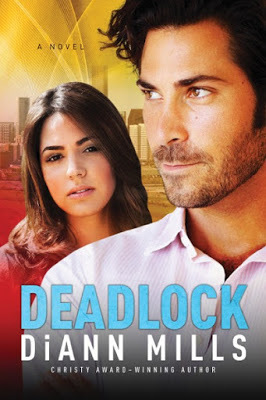 Deadlock
Deadlock
by DiAnn Mills
Two murders have rocked the city of Houston. Are they the work of a serial killer, or is a copycat trying to get away with murder?
That is the question facing Special Agent Bethany Sanchez, who is eager for her new assignment in violent crimes but anxious about meeting her new partner. Special Agent Thatcher Graves once arrested her brother, and he has a reputation for being a maverick. Plus, their investigative styles couldn’t be more opposite: he operates on instinct, while she goes by the book.
When hot leads soon fizzle out, their differences threaten to leave them deadlocked. But an attempt on their lives turns up the heat and brings them closer together, and a third victim might yield the clue that will help them zero in on a killer. This could be the case of their careers . . . if they can survive long enough to solve it.
TWEETABLESGetting inside your character's head isn't as difficult as you think - @DiAnnMills (Click to Tweet)
Tips to get inside your character's head from @DiAnnMills on @EdieMelson (Click to Tweet)
 DiAnn Mills is a bestselling author who believes her readers should expect an adventure. She combines unforgettable characters with unpredictable plots to create action-packed, suspense-filled novels.
DiAnn Mills is a bestselling author who believes her readers should expect an adventure. She combines unforgettable characters with unpredictable plots to create action-packed, suspense-filled novels.
Her titles have appeared on the CBA and ECPA bestseller lists; won two Christy Awards; and been finalists for the RITA, Daphne Du Maurier, Inspirational Readers’ Choice, and Carol award contests. Library Journal presented her with a Best Books 2014: Genre Fiction award in the Christian Fiction category for Firewall.
DiAnn is a founding board member of the American Christian Fiction Writers; the 2015 president of the Romance Writers of America’s Faith, Hope, & Love chapter; a member of Advanced Writers and Speakers Association, and International Thriller Writers. She speaks to various groups and teaches writing workshops around the country. She and her husband live in sunny Houston, Texas.
DiAnn is very active online and would love to connect with readers on any of the social media platforms listed at www.diannmills.com.
 I’d like to introduce you to a few of my friends.
I’d like to introduce you to a few of my friends.This is Anna, the younger sister in Frozen. Sincere and optimistic. She’s full of love and a sense of adventure. But caring for her sister causes her to attempt a dangerous mission. A strong heroine, but avoid telling her no.
This is Elsa, the older sister in Frozen. Kinda hard to get to know because she’s afraid, mostly of herself. Rather stiff. Isolated. High maintenance when you consider she thinks she prefers the cold.
This is Woody, a nice cowboy kinda guy from Toy Story. Easy going. Takes life slow unless an emergency rises. Walks like he was born in the saddle. Dresses pretty much the same everyday. Low Maintenance.
 This is Mr. Potato Head, a man of many disguises. All he has to do is change his eyes, nose, mouth, hat or shoes, and he steps into a new role. Versatile. Low maintenance unless he chooses to be Mrs. Potato Head. Then you need to deal with hormones.
This is Mr. Potato Head, a man of many disguises. All he has to do is change his eyes, nose, mouth, hat or shoes, and he steps into a new role. Versatile. Low maintenance unless he chooses to be Mrs. Potato Head. Then you need to deal with hormones.Snow White - Everyone loves her. Miss Perfect. Always says and does the right things. High maintenance considering she needs a prince and 7 dwarfs to meet her needs. And she’s picky about apples.
TinkerBell - Now here’s a character with definition. She has strengths and weaknesses, goals and desires. Courageous. Knows how to analyze a situation. Basically low maintenance.
My friends have unique personalities. They show me who they are by how they physically, mentally, and emotionally react to the events around them. That’s how they become my heroes and heroines.
But what happens when one of my animated friends is picked up by a child who has a vivid imagination? That’s when the fun starts. A child has no rules to play except to make the character real, no dilemma changing a toy’s persona to match a personal game of make believe. And we writers are no exception. Unfortunately many of us have squelched our childlike imaginations, so we have to work to get the world of make believe back. I want to give you a few tools to help you create dynamic characters.
The best way to get inside a character’s head is decide who, what, where, when, why, and how. Just like a party invitation.Who? This involves the most work. But once this part is established, the rest of the questions are fairly easy to answer.What? What is the character’s role in your story? Does he or she like their role? Did you ask him/her that question?Where? Where does your story take place? How does your setting effect the characters and story line?When?What’s your time period? This is crucial so you can establish a culture and vocabulary.Why? Why this character for your story? If he is a protagonist, what traits give him a heroic quality? Does he even know he possess heroic qualities? What about your antagonist? Was he born with a desire to stand in the way of a protagonist’s goals?How? How will your character move throughout the story? What will your character do to achieve his goals?Getting inside your character’s head is not so difficult as long as you’re willing to spend a little time with him/her/it. Take the character to lunch. Play a round of golf. Once you think you have your answers, put the character in the middle of “what is the worst possible thing that could happen.” Sit back, let your fingers fly, and go deep inside your character’s head. But let me warn you, the deeper you go, the closer you get to the character’s heart. And oh the secrets you learn.
Let’s share a few tips. How do you get inside your character’s head?
Leave a comment below to be entered into a drawing for DiAnn's newest book.
 Deadlock
Deadlock
by DiAnn Mills
Two murders have rocked the city of Houston. Are they the work of a serial killer, or is a copycat trying to get away with murder?
That is the question facing Special Agent Bethany Sanchez, who is eager for her new assignment in violent crimes but anxious about meeting her new partner. Special Agent Thatcher Graves once arrested her brother, and he has a reputation for being a maverick. Plus, their investigative styles couldn’t be more opposite: he operates on instinct, while she goes by the book.
When hot leads soon fizzle out, their differences threaten to leave them deadlocked. But an attempt on their lives turns up the heat and brings them closer together, and a third victim might yield the clue that will help them zero in on a killer. This could be the case of their careers . . . if they can survive long enough to solve it.
TWEETABLESGetting inside your character's head isn't as difficult as you think - @DiAnnMills (Click to Tweet)
Tips to get inside your character's head from @DiAnnMills on @EdieMelson (Click to Tweet)
 DiAnn Mills is a bestselling author who believes her readers should expect an adventure. She combines unforgettable characters with unpredictable plots to create action-packed, suspense-filled novels.
DiAnn Mills is a bestselling author who believes her readers should expect an adventure. She combines unforgettable characters with unpredictable plots to create action-packed, suspense-filled novels. Her titles have appeared on the CBA and ECPA bestseller lists; won two Christy Awards; and been finalists for the RITA, Daphne Du Maurier, Inspirational Readers’ Choice, and Carol award contests. Library Journal presented her with a Best Books 2014: Genre Fiction award in the Christian Fiction category for Firewall.
DiAnn is a founding board member of the American Christian Fiction Writers; the 2015 president of the Romance Writers of America’s Faith, Hope, & Love chapter; a member of Advanced Writers and Speakers Association, and International Thriller Writers. She speaks to various groups and teaches writing workshops around the country. She and her husband live in sunny Houston, Texas.
DiAnn is very active online and would love to connect with readers on any of the social media platforms listed at www.diannmills.com.
Published on October 28, 2015 01:00
October 27, 2015
How to Brainstorm Your Way to NaNoWriMo—Idea Sparking Style
Edie here. In honor of NaNoWriMo, I've convinced my writing buddy and fellow My Book Therapy team member to share some tips. Michelle Lim is a writer who knows how to make ideas spark when it comes to brainstorming. Her newest book, Idea Sparking: 30 Idea Sparks to Write a Novel in a Month is available today for only .99 cents on Amazon. So join me and get inspired for NaNoWriMo!
How to Brainstorm Your Way into NaNoWriMo Success!
by Michelle Lim @MichelleLim24
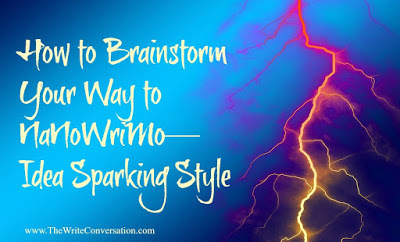 Brainstorm your way to NaNoWriMo success!National Novel Writing Month is one week away and many of us have taken the plunge, committing to write a novel in a month.
Brainstorm your way to NaNoWriMo success!National Novel Writing Month is one week away and many of us have taken the plunge, committing to write a novel in a month.
How about you? Have you taken the leap? If so, you’ve likely stockpiled a stash of caffeine and chocolate to survive the next millennium on sugar alone.
Before you empty the chocolate aisle at your grocery store, perhaps it’s time to get a carefully developed brainstorming game plan.
It isn’t just thinking up elements of your story before you write the rough draft. Each day of the thirty-day novel writing challenge you must awaken your brain to the richness of your story before you start.
Why?
Writer’s block can gobble up time faster than the calendar. It is one of your greatest enemies to word count when on deadline or participating in a challenge like NaNoWriMo.
How to Brainstorm Your Way into Words - Idea Sparking Style: Idea spark before you sit down to write.*Idea Spark before you sit down to write. Brainstorming is flexing your brain muscles each day before you start writing to maximize your word count. It gets the ideas flowing about your story and prepares you before you get to the page.
Idea spark before you sit down to write.*Idea Spark before you sit down to write. Brainstorming is flexing your brain muscles each day before you start writing to maximize your word count. It gets the ideas flowing about your story and prepares you before you get to the page.
*Idea Spark with a writing buddy. Talking out loud to yourself isn’t nearly as inspiring as sparking ideas with a friend. Determine who your brainstorming buddy will be and plan five to ten minutes to talk about what you’ll be writing that day.
*Idea Spark sensory details. Discuss the mood of the scene and brainstorm ways the senses can be experienced by the character in that location to showcase that mood. This can give you a head start on seeing through your point of view character’s eyes. It will also help you recognize if the location you’ve selected for the scene is less powerful than another location might be.
What idea sparks bring about the greatest word count for you?
Another resource that can help you with NaNoWriMo is my newest book release available on Amazon today for $0.99.
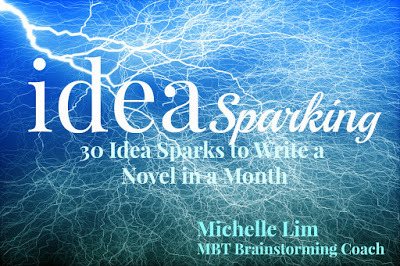 Idea Sparking!My newest release: Idea Sparking: 30 Idea Sparks to Write a Novel in a Month is a great way to help you spark your novel. Why?
Idea Sparking!My newest release: Idea Sparking: 30 Idea Sparks to Write a Novel in a Month is a great way to help you spark your novel. Why?
Idea Sparking: 30 Idea Sparks to Write a Novel in a Month accompanies an author on a thirty-day novel journey. Daily idea prompts assist authors in finding the inspiration to write. With personal experience insights and goal setting reflections, this book is the perfect resource for the writer who wants to write a novel in a month, or the author looking for a resource for their everyday writing journey. What you will find in this incredible resource:
*A weekly inspirational focus to get you ready to write
*Daily Idea Sparks to spark your creativity and get you writing
*Mini writing craft tips that enhance your writing
*Daily Mid-day Milestones with thought-provoking questions to improve writing habits
*Weekly Check-Ups to retune your process to set you up for success
Join the Idea Sparking adventure: a Rafflecopter giveaway
And don't forget to share your own Idea Sparking ideas in the comments section below!
TWEETABLES
How to Brainstorm Your Way into #NaNoWriMo - @MichelleLim24 on @EdieMelson (Click to Tweet)
Don't go into #NaNoWriMo unprepared! Idea Sparking tips from @MichelleLim24 (Click to Tweet)
 Author Michelle Lim is the Brainstorming Coach with My Book Therapy Press and the Midwest Zone Director for American Christian Fiction Writers. Her Genesis winning romantic suspense is represented with Books & Such Literary Agency. Michelle’s Newest Release - Idea Sparking: 30 Idea Sparks to Write a Novel in a Month is available on Amazon this week. Through public speaking and online chats Michelle helps writers discover the revolutionary power of brainstorming to bring new life to their stories. Connect with Michelle on Facebook, Twitter at @MichelleLim24, or her blog at www.thoughtsonplot.worpress.com.
Author Michelle Lim is the Brainstorming Coach with My Book Therapy Press and the Midwest Zone Director for American Christian Fiction Writers. Her Genesis winning romantic suspense is represented with Books & Such Literary Agency. Michelle’s Newest Release - Idea Sparking: 30 Idea Sparks to Write a Novel in a Month is available on Amazon this week. Through public speaking and online chats Michelle helps writers discover the revolutionary power of brainstorming to bring new life to their stories. Connect with Michelle on Facebook, Twitter at @MichelleLim24, or her blog at www.thoughtsonplot.worpress.com.
How to Brainstorm Your Way into NaNoWriMo Success!
by Michelle Lim @MichelleLim24
 Brainstorm your way to NaNoWriMo success!National Novel Writing Month is one week away and many of us have taken the plunge, committing to write a novel in a month.
Brainstorm your way to NaNoWriMo success!National Novel Writing Month is one week away and many of us have taken the plunge, committing to write a novel in a month. How about you? Have you taken the leap? If so, you’ve likely stockpiled a stash of caffeine and chocolate to survive the next millennium on sugar alone.
Before you empty the chocolate aisle at your grocery store, perhaps it’s time to get a carefully developed brainstorming game plan.
It isn’t just thinking up elements of your story before you write the rough draft. Each day of the thirty-day novel writing challenge you must awaken your brain to the richness of your story before you start.
Why?
Writer’s block can gobble up time faster than the calendar. It is one of your greatest enemies to word count when on deadline or participating in a challenge like NaNoWriMo.
How to Brainstorm Your Way into Words - Idea Sparking Style:
 Idea spark before you sit down to write.*Idea Spark before you sit down to write. Brainstorming is flexing your brain muscles each day before you start writing to maximize your word count. It gets the ideas flowing about your story and prepares you before you get to the page.
Idea spark before you sit down to write.*Idea Spark before you sit down to write. Brainstorming is flexing your brain muscles each day before you start writing to maximize your word count. It gets the ideas flowing about your story and prepares you before you get to the page.*Idea Spark with a writing buddy. Talking out loud to yourself isn’t nearly as inspiring as sparking ideas with a friend. Determine who your brainstorming buddy will be and plan five to ten minutes to talk about what you’ll be writing that day.
*Idea Spark sensory details. Discuss the mood of the scene and brainstorm ways the senses can be experienced by the character in that location to showcase that mood. This can give you a head start on seeing through your point of view character’s eyes. It will also help you recognize if the location you’ve selected for the scene is less powerful than another location might be.
What idea sparks bring about the greatest word count for you?
Another resource that can help you with NaNoWriMo is my newest book release available on Amazon today for $0.99.
 Idea Sparking!My newest release: Idea Sparking: 30 Idea Sparks to Write a Novel in a Month is a great way to help you spark your novel. Why?
Idea Sparking!My newest release: Idea Sparking: 30 Idea Sparks to Write a Novel in a Month is a great way to help you spark your novel. Why?Idea Sparking: 30 Idea Sparks to Write a Novel in a Month accompanies an author on a thirty-day novel journey. Daily idea prompts assist authors in finding the inspiration to write. With personal experience insights and goal setting reflections, this book is the perfect resource for the writer who wants to write a novel in a month, or the author looking for a resource for their everyday writing journey. What you will find in this incredible resource:
*A weekly inspirational focus to get you ready to write
*Daily Idea Sparks to spark your creativity and get you writing
*Mini writing craft tips that enhance your writing
*Daily Mid-day Milestones with thought-provoking questions to improve writing habits
*Weekly Check-Ups to retune your process to set you up for success
Join the Idea Sparking adventure: a Rafflecopter giveaway
And don't forget to share your own Idea Sparking ideas in the comments section below!
TWEETABLES
How to Brainstorm Your Way into #NaNoWriMo - @MichelleLim24 on @EdieMelson (Click to Tweet)
Don't go into #NaNoWriMo unprepared! Idea Sparking tips from @MichelleLim24 (Click to Tweet)
 Author Michelle Lim is the Brainstorming Coach with My Book Therapy Press and the Midwest Zone Director for American Christian Fiction Writers. Her Genesis winning romantic suspense is represented with Books & Such Literary Agency. Michelle’s Newest Release - Idea Sparking: 30 Idea Sparks to Write a Novel in a Month is available on Amazon this week. Through public speaking and online chats Michelle helps writers discover the revolutionary power of brainstorming to bring new life to their stories. Connect with Michelle on Facebook, Twitter at @MichelleLim24, or her blog at www.thoughtsonplot.worpress.com.
Author Michelle Lim is the Brainstorming Coach with My Book Therapy Press and the Midwest Zone Director for American Christian Fiction Writers. Her Genesis winning romantic suspense is represented with Books & Such Literary Agency. Michelle’s Newest Release - Idea Sparking: 30 Idea Sparks to Write a Novel in a Month is available on Amazon this week. Through public speaking and online chats Michelle helps writers discover the revolutionary power of brainstorming to bring new life to their stories. Connect with Michelle on Facebook, Twitter at @MichelleLim24, or her blog at www.thoughtsonplot.worpress.com.
Published on October 27, 2015 01:00
October 26, 2015
Blogging Success is as Easy as ABC - Blogging Basics for Writers, Part 7
by Edie Melson @EdieMelson
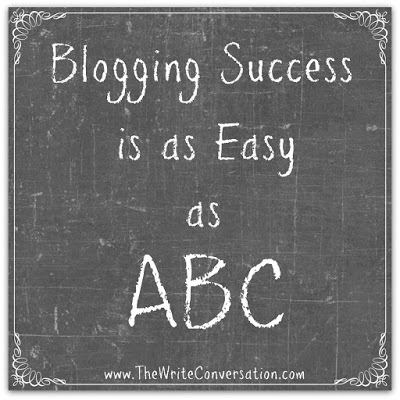 As Easy as ABCToday I’d like to give you 26 tips for success with your blog. I’m calling this my ABCs of Blogging.
As Easy as ABCToday I’d like to give you 26 tips for success with your blog. I’m calling this my ABCs of Blogging.
A is for Accessibility—Make sure your blog is easy to find, easy to navigate, and easy to read. And don’t forget to make it accessible to those who are visually impaired.
B is for Basics—Whatever you’re doing, make it excellent. That means take time to check for typos and readability, in your posts. Also be sure you’re using giving accurate links. There’s nothing more frustrating than clicking on a link that takes you nowhere.
D is for Discipline—When you begin a blog, you make a commitment to your audience. You want them to show up regularly and they expect the same for you. They won’t expect perfection—after all life happens to all of us—but they will expect discipline from you.
 E is for EnergyE is for Energy—Make sure your posts are full of energy. Use active verbs, vibrant descriptions and always end with a call to action. The action could be as simple as joining the conversation or as challenging as changing the world.
E is for EnergyE is for Energy—Make sure your posts are full of energy. Use active verbs, vibrant descriptions and always end with a call to action. The action could be as simple as joining the conversation or as challenging as changing the world.
F is for Focus—You cannot be everything to everybody. Pick a focus for your site, but don’t be afraid to refine it based on what you hear from your audience.
G is for Google—Do your homework and know what it takes to rank high in the search engines. This means you need to know about SEO (Search Engine Optimization), as well as how to label and tag your blog correctly. And always remember it isn’t content that’s king, it’s GOOD content that rules.
 H is for HearingH is for Hearing—Pay close attention to the comments your audience leaves. You’ll find great ideas for future blogs, as well as find out what your audience is interested in. Also keep tabs on your analytics. Knowing which posts are your most popular will go a long way to helping you determine the focus for you blog.
H is for HearingH is for Hearing—Pay close attention to the comments your audience leaves. You’ll find great ideas for future blogs, as well as find out what your audience is interested in. Also keep tabs on your analytics. Knowing which posts are your most popular will go a long way to helping you determine the focus for you blog.
I is for Image—There’s a reason behind the saying, “A picture is worth a thousand words.” Use images to illustrate every post and to break up the text so it’s easier to read.
J is for Jump Break—This little tool can help your blog load faster and your email notifications run smoother. Not sure what I’m talking about? Here’s a post I wrote that give you everything you need to know about jump breaks.
K is for Keeping On—Building an audience for your blog takes time . . . and diligence. Don’t give up too soon. Here’s what to reasonably expect for blog growth.
L is for Links— Social Media Links, that is. If someone takes time to visit your blog, make sure they can connect with you on social media as well. Have all your social media links in an easy to see place on your blog header or sidebar.
 M is for MobileM is for Mobile—Make sure your blog is easy to read on a mobile device and/or tablet. This isn’t just about how it looks, but also the length of posts, size of the text, etc.
M is for MobileM is for Mobile—Make sure your blog is easy to read on a mobile device and/or tablet. This isn’t just about how it looks, but also the length of posts, size of the text, etc.
N is for Numbers—Remember your worth—and your blog’s worth— is NOT determined by the number of people who visit.
P is for Passion—You may be able to write about something you’re not passionate about for a month or two. But after that, I guarantee you’ll be miserable. So pick something you’re passionate about as a focus for your site.
Q is for Question—Always end your post with a question to help get the conversation started. (Thanks to Jeanne Takenaka for reminding me to include this tip!)
R is for Reputation—In this business (publishing and blogging) reputation is everything. Develop a reputation for excellence and you’ll never lack for work—or for an audience!
S is for Subscribers—Make sure you have a way for people to subscribe to your blog through email and through RSS. Also, be sure you know the difference between blog followers and blog subscribers.
T is for Titles—Don’t neglect the titles you choose for your blog posts. Social media is a no man’s land without context. A good rule is to look at your title and ask if someone would know what your post was about just by reading the title.
U is for Understand—Take time to understand the culture of the online universe. This includes etiquette, as well as expectations.
 V is for ValueV is for Value—Give your audience something of value every single time you post. No one has time to waste and your audience is no exception.
V is for ValueV is for Value—Give your audience something of value every single time you post. No one has time to waste and your audience is no exception.
W is for Weight—Don’t overload any part of your blog. Keep your sidebars trim and uncluttered. Don’t have too many links within a blog post. The ideal is no more than two to three per 500 words. If you encourage people to click away more than a couple of times, statistics prove they won’t come back. But most of all, don’t weigh down your posts with unnecessary words. Wordiness is never a good thing for a writer, but it’s absolute death to a blogger.
X is for Examine—I try to evaluate my blog two to three times a year. I take a look at my most popular posts, as well as the ones that garnered the most comments. I also try to look at it like a first-time visitor would. Is it easy to navigate? Do the page tab titles make sense? Are my social media links all working correctly.
Y is for Yellow—Not as in cowardly, but the color yellow. Avoid it when you blog. It’s the most unpopular color for use on a blog. It’s also the hardest to see and has the largest variation over devices.
Z is for Zoom In—When you pick a topic for a blog post, zoom in. Don’t try to cover too much at once. Stay laser-focused. Beyond that, zoom in on your word count. Blog posts are almost always shorter than print articles. It’s the nature of the medium.
These are my top tips. I’d love to hear some of yours!
Don’t forget to join the conversation!Blessings,Edie
TWEETABLES#Blogging Success is as Easy as ABC – via #socialmedia expert @EdieMelson (Click to Tweet)
Blogging isn't a synonym for lecturing, plus other tips from @EdieMelson (Click to Tweet)
Blogging For Writers: If you've missed the previous posts in this series, here are the direct links:
Part 1 - Blog or Website, Which Does a Writer Really Need
Part 2 - So What Do I Blog About
Part 3 - The Dos & Don'ts of Blogging
Part 4 - How Fast Should a Blog Grow
Part 5 - Tips for Getting More Comments on Your Blog
Part 6 - What do I Need in My Blog's Sidebar
 As Easy as ABCToday I’d like to give you 26 tips for success with your blog. I’m calling this my ABCs of Blogging.
As Easy as ABCToday I’d like to give you 26 tips for success with your blog. I’m calling this my ABCs of Blogging.A is for Accessibility—Make sure your blog is easy to find, easy to navigate, and easy to read. And don’t forget to make it accessible to those who are visually impaired.
B is for Basics—Whatever you’re doing, make it excellent. That means take time to check for typos and readability, in your posts. Also be sure you’re using giving accurate links. There’s nothing more frustrating than clicking on a link that takes you nowhere.
D is for Discipline—When you begin a blog, you make a commitment to your audience. You want them to show up regularly and they expect the same for you. They won’t expect perfection—after all life happens to all of us—but they will expect discipline from you.
 E is for EnergyE is for Energy—Make sure your posts are full of energy. Use active verbs, vibrant descriptions and always end with a call to action. The action could be as simple as joining the conversation or as challenging as changing the world.
E is for EnergyE is for Energy—Make sure your posts are full of energy. Use active verbs, vibrant descriptions and always end with a call to action. The action could be as simple as joining the conversation or as challenging as changing the world.F is for Focus—You cannot be everything to everybody. Pick a focus for your site, but don’t be afraid to refine it based on what you hear from your audience.
G is for Google—Do your homework and know what it takes to rank high in the search engines. This means you need to know about SEO (Search Engine Optimization), as well as how to label and tag your blog correctly. And always remember it isn’t content that’s king, it’s GOOD content that rules.
 H is for HearingH is for Hearing—Pay close attention to the comments your audience leaves. You’ll find great ideas for future blogs, as well as find out what your audience is interested in. Also keep tabs on your analytics. Knowing which posts are your most popular will go a long way to helping you determine the focus for you blog.
H is for HearingH is for Hearing—Pay close attention to the comments your audience leaves. You’ll find great ideas for future blogs, as well as find out what your audience is interested in. Also keep tabs on your analytics. Knowing which posts are your most popular will go a long way to helping you determine the focus for you blog.I is for Image—There’s a reason behind the saying, “A picture is worth a thousand words.” Use images to illustrate every post and to break up the text so it’s easier to read.
J is for Jump Break—This little tool can help your blog load faster and your email notifications run smoother. Not sure what I’m talking about? Here’s a post I wrote that give you everything you need to know about jump breaks.
K is for Keeping On—Building an audience for your blog takes time . . . and diligence. Don’t give up too soon. Here’s what to reasonably expect for blog growth.
L is for Links— Social Media Links, that is. If someone takes time to visit your blog, make sure they can connect with you on social media as well. Have all your social media links in an easy to see place on your blog header or sidebar.
 M is for MobileM is for Mobile—Make sure your blog is easy to read on a mobile device and/or tablet. This isn’t just about how it looks, but also the length of posts, size of the text, etc.
M is for MobileM is for Mobile—Make sure your blog is easy to read on a mobile device and/or tablet. This isn’t just about how it looks, but also the length of posts, size of the text, etc. N is for Numbers—Remember your worth—and your blog’s worth— is NOT determined by the number of people who visit.
P is for Passion—You may be able to write about something you’re not passionate about for a month or two. But after that, I guarantee you’ll be miserable. So pick something you’re passionate about as a focus for your site.
Q is for Question—Always end your post with a question to help get the conversation started. (Thanks to Jeanne Takenaka for reminding me to include this tip!)
R is for Reputation—In this business (publishing and blogging) reputation is everything. Develop a reputation for excellence and you’ll never lack for work—or for an audience!
S is for Subscribers—Make sure you have a way for people to subscribe to your blog through email and through RSS. Also, be sure you know the difference between blog followers and blog subscribers.
T is for Titles—Don’t neglect the titles you choose for your blog posts. Social media is a no man’s land without context. A good rule is to look at your title and ask if someone would know what your post was about just by reading the title.
U is for Understand—Take time to understand the culture of the online universe. This includes etiquette, as well as expectations.
 V is for ValueV is for Value—Give your audience something of value every single time you post. No one has time to waste and your audience is no exception.
V is for ValueV is for Value—Give your audience something of value every single time you post. No one has time to waste and your audience is no exception.W is for Weight—Don’t overload any part of your blog. Keep your sidebars trim and uncluttered. Don’t have too many links within a blog post. The ideal is no more than two to three per 500 words. If you encourage people to click away more than a couple of times, statistics prove they won’t come back. But most of all, don’t weigh down your posts with unnecessary words. Wordiness is never a good thing for a writer, but it’s absolute death to a blogger.
X is for Examine—I try to evaluate my blog two to three times a year. I take a look at my most popular posts, as well as the ones that garnered the most comments. I also try to look at it like a first-time visitor would. Is it easy to navigate? Do the page tab titles make sense? Are my social media links all working correctly.
Y is for Yellow—Not as in cowardly, but the color yellow. Avoid it when you blog. It’s the most unpopular color for use on a blog. It’s also the hardest to see and has the largest variation over devices.
Z is for Zoom In—When you pick a topic for a blog post, zoom in. Don’t try to cover too much at once. Stay laser-focused. Beyond that, zoom in on your word count. Blog posts are almost always shorter than print articles. It’s the nature of the medium.
These are my top tips. I’d love to hear some of yours!
Don’t forget to join the conversation!Blessings,Edie
TWEETABLES#Blogging Success is as Easy as ABC – via #socialmedia expert @EdieMelson (Click to Tweet)
Blogging isn't a synonym for lecturing, plus other tips from @EdieMelson (Click to Tweet)
Blogging For Writers: If you've missed the previous posts in this series, here are the direct links:
Part 1 - Blog or Website, Which Does a Writer Really Need
Part 2 - So What Do I Blog About
Part 3 - The Dos & Don'ts of Blogging
Part 4 - How Fast Should a Blog Grow
Part 5 - Tips for Getting More Comments on Your Blog
Part 6 - What do I Need in My Blog's Sidebar
Published on October 26, 2015 01:00



